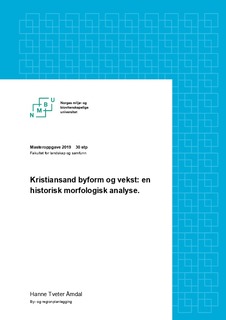| dc.contributor.advisor | Børrud, Elin | |
| dc.contributor.author | Åmdal, Hanne Tveter | |
| dc.coverage.spatial | Norway, Kristiansand | nb_NO |
| dc.date.accessioned | 2019-10-30T13:08:30Z | |
| dc.date.available | 2019-10-30T13:08:30Z | |
| dc.date.issued | 2019 | |
| dc.identifier.uri | http://hdl.handle.net/11250/2625421 | |
| dc.description.abstract | Byens vesen er komplekst og i stadig endring. Opp gjennom historien har byens form endret seg i tråd med ønsker og intensjoner fra bysamfunnet. Byene slik vi kjenner dem i dag er et resultat av endringene som har skjedd opp gjennom byens historie. Dette gjør at beslutninger tatt for mange hundre år siden kan ha en betydning på den byen vi ser i dag. Læren om byens form og hvordan denne har endret seg over tid i tråd bysamfunnets forutsetninger kalles urban morfologi.
Oppgaven er en historisk morfologisk analyse som forsøker å belyse og forklare Kristiansands byform og hvorfor den har vokst frem på denne måten. Analysens hovedformål er å illustrere og forklare den fysiske utviklingen av byen slik det faktisk har skjedd og belyse de bakenforliggende prosessene for denne endringen. I dag er Kristiansand en spredtbygd by med bebyggelse fra Flekkerøya og Voiebyen i Sør, Hellemyr i vest, Justvik i nord, Hånes og Søm i vest, med Kvadraturen som sentrum. Resultatet fra den morfologiske analysen i oppgaven viser at denne bystrukturen i stor grad er et resultat av boligutfordringene i Kristiansand etter krigen og planleggernes forsøke på å løse dette.
Hovedspørsmålet denne oppgaven ønsker å belyse er på hvilken måte den tidligere kommunesammenslåingen mellom Kristiansand, Oddernes, Randesund og Tveit i 1965 har påvirket byens form. Resultatene fra den morfologiske analysen viser at kommunesammenslåingen, eller rettere sagt mangel på en kommunesammenslåing har hatt en stor betydning for Kristiansands byform. Funnene er i hovedsak knyttet til den faktiske kommunegrensen og forskjellene i kommunenes interne forutsetninger og arealpolitikk.
Hovedfunnet i oppgaven er altså at kommunesammenslåingen har hatt en betydning på byens form. Dette resultatet er spennende når Kristiansand i 2020 skal inn i en ny kommunesammenslåing, denne gangen med Søgne og Sogndalen. Siden den tidligere kommunesammenslåingen påvirket byens form i stor grad er dette en indikasjon på at denne kan skje igjen. | nb_NO |
| dc.description.abstract | A city is complex and constantly changing. Throughout history, the shape of a city has changed in line with wishes and intentions of the urban society. The cities as we know them are a result of the changes that have occurred through its history. This means that decisions taken hundreds of years ago can have an impact on the city we see today. The study of urban form and how is has changed over time as a result of the urban society, is called urban morphology.
This thesis is a historical morphological analysis that attempts to elucidate and explain the urban form of Kristiansand and why it has emerged like this. The main purpose of the analysis is to illustrate and explain the physical development of the city as it actually happened and to illuminate the underlying processes of this change. Today, Kristiansand is a scattered town with settlements from Flekkerøya and Voiebyen in the south, Hellemyr in the west, Justvik in the north, Hånes and Søm in the west, with Kvadraturen as the center. The result of the morphological analysis in the thesis shows that this urban structure is largely a result of the housing challenges in Kristiansand after the world war II and the planners' attempts to solve this issue.
The main task of this thesis is to elucidate how the former municipal merge between Kristiansand, Oddernes, Randesund and Tveit in 1965 has influenced the urban form. The results from the morphological analysis show that the merge of municipalities, or rather the lack of this merge, has had a major impact on the urban form of Kristiansand. The findings are mainly related to the actual municipal boundary and the differences in the municipalities' internal land development strategies.
The main finding in the thesis is that the municipal merge has had an impact on the urban form. This result is exciting in relation to the new municipal merge in 2020, with Kristiansand, Søgne and Sogndalen. Since the former municipal merge affected the urban form to a large extent, is it possible to imagine that this will be the result again. | nb_NO |
| dc.language.iso | nob | nb_NO |
| dc.publisher | Norwegian University of Life Sciences, Ås | nb_NO |
| dc.rights | Attribution-NonCommercial-NoDerivatives 4.0 Internasjonal | * |
| dc.rights.uri | http://creativecommons.org/licenses/by-nc-nd/4.0/deed.no | * |
| dc.subject | Kristiansand | nb_NO |
| dc.subject | Urban morfologi | nb_NO |
| dc.subject | Historie | nb_NO |
| dc.title | Kristiansand byform og vekst : en historisk morfologisk analyse | nb_NO |
| dc.type | Master thesis | nb_NO |
| dc.source.pagenumber | 104 | nb_NO |
| dc.description.localcode | M-BYREG | nb_NO |

